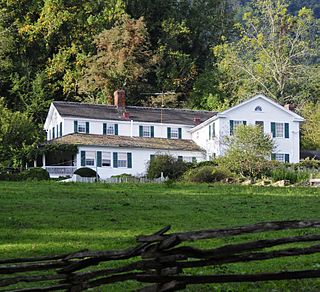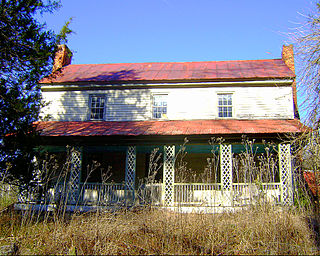
Horne Creek Farm is a historical farm near Pinnacle, Surry County, North Carolina. The farm is a North Carolina State Historic Site that belongs to the North Carolina Department of Natural and Cultural Resources, and it is operated to depict farm life in the northwest Piedmont area c. 1900. The historic site includes the late 19th century Hauser Farmhouse, which has been furnished to reflect the 1900-1910 era, along with other supporting structures. The farm raised animal breeds that were common in the early 20th century. The site also includes the Southern Heritage Apple Orchard, which preserves about 800 trees of about 400 heritage apple varieties. A visitor center includes exhibits, a gift shop and offices.
Davidson House is a historic home located near Troutman, Iredell County, North Carolina. The original section was built about 1805, and enlarged and remodeled in the Federal period about 1830. It is a 1+1⁄2-story, two bay by two bay, log dwelling sheathed in weatherboard. It has a hall and parlor plan, front shed porch, rear shed rooms and porch, and a single should brick chimney. Also on the property is a contributing two-story three-bay wide, half-dovetail log barn.
Tuckasegee, named after the historic Cherokee town of that name located near here, is an unincorporated community in Jackson County, North Carolina, United States. It followed the earlier Cherokee town as developing on the upper Tuckaseegee River, at the confluence of its East and West forks.
Albert Gamaliel Jones was a notable "house carpenter" from Warren County, North Carolina. He built "distinctive" Greek Revival plantation houses and college buildings.

The Withers Log House, at 344 Wassou in Crystal Bay, Nevada, is a historic house that was built in 1931. It was listed on the National Register of Historic Places in 2000.

Spring Bank, also known as Ravenscroft and Magnolia Grove, is a historic plantation house located near Lunenburg, Lunenburg County, Virginia. It was built about 1793, and is a five-part Palladian plan frame dwelling in the Late Georgian style. It is composed of a two-story, three-bay center block flanked by one-story, one-bay, hipped roof wings with one-story, one-bay shed-roofed wings at the ends. Also on the property are the contributing smokehouse, a log slave quarter, and frame tobacco barn, and the remains of late-18th or early-19th century dependencies, including a kitchen/laundry, ice house, spring house, and a dam. Also located on the property are a family cemetery and two other burial grounds. It was built by John Stark Ravenscroft (1772–1830), who became the first Bishop of the Episcopal Diocese of North Carolina, serving from 1823 to 1830.

Sherrill's Inn is a historic home located near Fairview, Buncombe County, North Carolina. It is a four bay by two bay, log house of the saddle-bag variety which has been raised to two stories and weatherboarded. Attached to it is an originally separate two-story, log building, two bays wide and two bays deep. Also on the property are a contributing stone spring house and log meathouse. The building was built about 1845, and used as an inn throughout much of the 19th century.

Longwood is a historic plantation house located near Milton, Caswell County, North Carolina. The original section was built about 1810, and is a two-story, four bay by one bay Federal style frame block. It has a two bay wide and one bay deep Greek Revival style addition forming an overall "L"-shaped dwelling. The interior features woodwork attributed to noted African-American cabinetmaker Thomas Day. Also on the property are the frame kitchen, log corn crib, log tenant house, and log tobacco barn. It is believed to have been the home of U.S. Congressman Romulus Mitchell Saunders early in his career.
Hampton House is a historic home located near Arcadia, Davidson County, North Carolina. It was built about 1879, and is a two-story, three bay, frame I-house of simple Greek Revival style. The 1+1⁄2-story rear wing is of log construction and dates to the early-19th century. It was attached to the main block at the time of its construction in 1879. Also on the property is a contributing pegged frame granary.
Brummell's Inn is a historic inn and tavern located near Thomasville, Davidson County, North Carolina. It was originally constructed as a small log house in the late-18th / early-19th century. It was expanded in about 1814 in a vernacular Late Georgian / Early Federal style, with later additions. The resultant building is two-stories and eight bays wide. Also on the property are a contributing smokehouse, barn, and cemetery. The stagecoach inn operated into the 1850s, after which it was used as a dwelling house.
Archibald H. Davis Plantation, also known as Cypress Hall, is a historic plantation house and complex located near Justice, Franklin County, North Carolina. The house was built about 1820, and is a two-story, five bay, Greek Revival style frame dwelling. It has a full width front porch and rear ell added in the early-20th century. Also on the property are log tobacco barns, a small barn, a larger barn, domestic outbuildings, and a building said to have been a trading post or stagecoach stop.
Col. Richard P. Taylor House is a historic plantation complex and national historic district located near Huntsboro, Granville County, North Carolina. The plantation house was built about 1835, and is a tall two-story, five bay, transitional Federal / Greek Revival style frame dwelling. It has a one-story rear ell, exterior end chimneys, and a full-height brick basement. The house is nearly identical to that built by Col. Richard Taylor's half-brother, the Archibald Taylor Plantation House. Also on the property are the contributing early mortise and tenon smokehouse, a pigeon house or tobacco packhouse, an air-cure tobacco barn, a frame corn crib, and two log tobacco barns.
Marcus Royster Plantation is a historic tobacco plantation house and national historic district located near Wilbourns, Granville County, North Carolina. The house was built about 1850, and is a two-story, three bay, "T"-plan, heavy timber frame Greek Revival style dwelling. It has a low hipped roof and classical portico. Also on the property are the contributing air-curing barn, smokehouse, two log tobacco barns, log corn crib, two frame barns, a small log barn, frame smokehouse, and a frame former tenant house.
Rose Hill is a historic tobacco plantation house and national historic district located near Grassy Creek, Granville County, North Carolina. The house was built about 1834, and is a two-story, three bay by two bay, Greek Revival style red brick dwelling. It has a low hipped roof and a Colonial Revival style front porch added in the late-19th or early-20th century. Also on the property are the contributing garage, two frame corn cribs, four log tobacco barns, a log striphouse, a frame packhouse, and a tenant house.

Daltonia, also known as the John H. Dalton House, was a historic home located near Houstonville, Iredell County, North Carolina. It was built in 1858, and is a two-story, three-bay by two-bay, Greek Revival style frame dwelling. It has a gable roof, two-story rear ell, and the front facade features a two-story pedimented portico. Also on the property is a contributing 1+1⁄2-story small log house and a loom house.
Waddle–Click Farm is a historic home and farm complex located near Statesville, Iredell County, North Carolina. The Federal style house was built between about 1820 and 1835, and is a two-story, three bay by two bay, log dwelling. Also on the property are a contributing well house, smokehouse, log slave cabin, granary / corn crib, hay barn / stable, and a shed.

Bingham School is a historic school complex located at Oaks, Orange County, North Carolina. The complex includes a large, expansive, multi-stage headmaster's house, a contemporary smokehouse and well house. The oldest section of the house is a log structure that forms the rear ell and dates to the early 19th century. Attached to it is a frame addition. The front section of the house, is a two-story Greek Revival style, three bay by two bay, frame block dated to about 1845. The rear of the house features a colonnaded porch with Doric order columns that carries along the rear of the two-story section and the front of the ell. The school operated at this location from about 1845 to near the end of the American Civil War.
Barber Farm, also known as Luckland, is a historic farm complex and national historic district located near Cleveland, Rowan County, North Carolina. The Jacob Barber House was built about 1855, and is a two-story, single-pile, three-bay vernacular Greek Revival style frame dwelling. It has a one-story rear ell and a one-story shed roofed rear porch. Its builder James Graham also built the Robert Knox House and the Hall Family House. Other contributing resources are the cow barn, smokehouse, granary, double crib log barn, well house, log corn crib / barn, carriage house, school, Edward W. Barber House (1870s), Edward W. Barber Well House (1870s), North Carolina Midland Railroad Right-of-Way, and the agricultural landscape.

George W. Logan House, also known as Jobe Hill, is a historic home located near Rutherfordton, Rutherford County, North Carolina. It built about 1842, and is a one-story, five bay, Georgian plan frame dwelling. It is sheathed in weatherboard, has a side gable roof, and two rebuilt exterior end chimneys. It was enlarged and remodeled in the 1890s and in 1985. Also on the property are the contributing brick well house, dairy, outhouse, smokehouse, granary, log double corncrib, and a large log barn. It was the home of prominent North Carolina politician George Washington Logan (1815-1889).

Holbrook Farm is a historic farm complex located near Traphill, Wilkes County, North Carolina. The house was built about 1826, and is a vernacular two story, three bay frame dwelling with Federal style design elements. Also on the property are the contributing log granary, log spring house, a log smokehouse, a log corn crib, a frame barn, and a board-and-batten two-room school dormitory that once served the Trap Hill Institute and moved to the property in the early-20th century.












